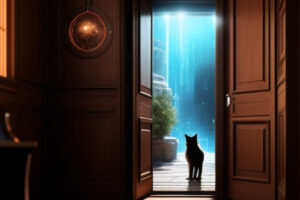Romeo and Juliet’s love is stronger than anything else, but their families have cultivated a deep hatred for each other and do not want to allow them to marry in any way, and in their unhappiness they are exiled each in their own nebula.
But Romeo and Juliet are physicists and their geniuses are well above average. They therefore secretly find a wormhole between the two nebulae.
From the outside, the openings of the wormholes resemble two black holes; one is in Romeo’s nebula, the other in Juliet’s nebula.
The young lovers throw themselves into these black holes and their families believe that their unbearable desire has led them both to take their own lives.
This is what Shakespeare’s famous play might look like if it were rewritten in the form of science fiction. The sci-fi might even have a happy ending:
In the worm tunnel, the overwhelming force of gravity whips Romeo and Juliet into each other’s arms and they can enjoy love in the middle of the worm tunnel.
They are now not only in a different place in space, but also in a different time.
The universe’s time machines are disguised as black holes.
The idea of a wormhole in space can be traced back to Albert Einstein’s theory of relativity . If wormholes exist, they are most likely disguised as black holes, and physicists have so far considered it impossible to find them, precisely because it is impossible to see what happens in a black hole.
Now, new theories suggest that, despite everything, the wormhole may have some special features that make it possible to identify it – and thus find the entrance to the universe’s secret time machines.
The space-time is U-shaped
The laws of physics do not forbid the existence of wormholes because, according to the theory of relativity, gravity affects both space and time. Einstein connected the three-dimensional reality with time in so-called space-time, which has four dimensions.
It is impossible for us to visualize four dimensions, which is why spacetime is often visualized as a two-dimensional carpet filled with massive objects.
The force of gravity from a globe as small as the Earth does not dent spacetime more than corresponds to the dent formed in the upholstery of a dining chair when a person sits on it. However, extremely heavy and dense objects such as black holes bend spacetime so much that they form a deep well in it.
If the bottoms of two such gravity wells meet, spacetime can warp so much that it becomes U-shaped.
A wormhole connects the past and the future
Worm tunnels are shortcuts between regions of spacetime that are warped by the supermassive black holes. A trip through such a channel may end up in a different nebula at a different time.
2. Worm tunnels run between different times
Some black holes in the middle of nebulae could be entrances to wormholes that form a shortcut between the nebulae. If you go through opening A, you end up in the future outside of B. In the other direction, we go to the beginning of the journey in the past.
When a photon travels down one U-tube, takes the bottom curve, and then goes up the other U-tube, it ends its journey very close to the starting point. And if she lands in here in a straight channel between the layers, she can shoot through that channel and get back to where she was at the beginning. She is thus caught in the past.
Or the other way around: If the photon penetrates the channel at the very beginning of its journey, it saves the time the U-journey takes and thus shortens its path into the future.
If wormholes exist at all, they form what is said to be shortcuts through time and space and thus allow time travel both forward and back in time. And theoretically, two photons could meet halfway, just like Romeo and Juliet in the fictional science fiction.
Foreign substances pave the way
Worm tunnels really got on the physicists’ agenda at the end of the 1980s, when the American Nobel laureate Kip Thorne calculated that, theoretically, spaceships could be sent through the channel between the openings of the worm tunnel. For that, however, so-called foreign or “exotic” material would be needed to keep the channel open.
Also read:
All ordinary matter has mass and at the same time positive energy. Thus, it affects other matter with its gravitational force. Foreign material that is literally less than nothing, however, has a negative energy that acts as a repellant.
If the wormhole channel has a thin shell of alien material, that shell keeps the channel open so that the spacecraft can travel through the channel to other locations in both space and time.
This sounds like complete fantasy, but experiments have shown that it is possible to create tiny areas of negative energy, thus proving the existence of this alien material.
The ancient wormhole
The idea that supermassive black holes are actually entrances to wormholes was put forward in 2006 and was conceived by Russian physicist Igor Novikov at the University of Copenhagen.
The theory is based on the idea that a large number of black holes were formed immediately after the Big Bang, when spacetime was so dense that it could best be compared to foam.
There, some of the black holes came into contact and connected with each other, forming a wormhole.
The expansion of the universe has drawn out the wormhole.
As the universe expanded, the wormholes spread throughout the universe, which is now so vast that it actually is, and the channels between the openings connect distant nebulae, thus forming a vast network of short-cuts in time and space.
One of the leading scientists in the field of worm tunnel research is Juan Maldacena at Princeton University in the United States. Our science fiction novel about Romeo and Juliet comes from him. His calculations show that the geometric properties of wormholes opening in two nebulae may be such that it is possible to plunge into the two openings and meet halfway.
But Maldacena doesn’t think the young lovers will ever make it out again. Due to the expansion of the universe to all eight, the two openings are moving away from each other so fast that even at the speed of light, Romeo and Juliet would never make it out of the wormhole.
Other researchers disagree with this interpretation. Russian physicist Mikhail Piotrovitch of the St. Petersburg Astronomical Observatory believes that atoms entering a wormhole would come out the other side as ten trillion-degree hot plasma.
Accordingly, he considers it feasible to get all the way through a wormhole. But what’s more: He thinks it’s possible to find the wormhole.
Piotrovitch has tried to figure out what happens if both wormhole openings absorb gas. First, there is such a high acceleration at the end of the tunnel that the atoms form an enormously strong gravitational field, but then they enter the tunnel at a speed approaching the speed of light.
In the middle of the wormhole, the streams of atoms collide and melt together into a ten trillion degree hot plasma that expands at breakneck speed. The expansion pushes the gas molecules forward through the channel and out the tunnel openings. There, the plasma emits high-energy gamma radiation to all eight.
But that is not the case around supermassive black holes that absorb gas, which is why astronomers now believe they can detect wormholes through NASA’s space telescope, Fermi, which precisely measures gamma radiation.
If Piotrovitch was right, it would theoretically be possible for Romeo and Juliet to get out of the wormhole.
Other physicists have found another way to detect whether a wormhole can be disguised as a supermassive black hole.
A wormhole in the Milky Way
De-Chang Dai of Yangzhou University in China and Dejan Stojkovic of the University of Buffalo in the US have presented calculations regarding the conditions of the supermassive black hole at the center of the Milky Way. This black hole is not very active because it has exhausted all the gas from its surroundings, which is why astronomers have been able to map the orbit of the star S2, which orbits the black hole at a distance of only 20 billion kilometers.
If this supermassive black hole in our own nebula is actually one opening of a wormhole, and if a star also orbits the other end, the attraction of each star reaches the other through the shortcut created by the wormhole. And this should affect the orbit of the star S2 according to the calculations.
The next generation of giant telescopes with 30-40 meter mirrors, such as the ELT (Extremely Large Telescope) in Chile, will have good enough performance to detect possible effects on the orbit of this star. If such an effect is confirmed, we have found our own entrance to a wormhole and the possibility of time travel through space.
The idea of time travel is fascinating, but also terrifying, because it goes against our fixed image of time as a fixed dimension. However, there seems to be nothing in the laws of physics that prohibits time travel.
Air travel to the future
It has already been proven that it is possible to travel into the future. We do that simply by moving, especially when we go at high speed.
This may be difficult to understand, but imagine that time is a river flowing from the past into the future. We are all in a boat going with the current. To enter the future, all we need to do is start the outboard motor so that the boat goes faster than the water in the river.
In this way, millions of people travel daily a few billionths of a second into the future in airplanes traveling at a speed of a thousand kilometers. The time difference is so small that we don’t notice it and it can only be measured with an atomic clock.
If we are really going to travel to the future, we need a spaceship that can approach the speed of light. In such a spaceship, time passes noticeably slower.
Astronauts who went in such a fast spaceship far into space and back home, might have spent a year on the trip, but on earth ten years would have passed when they landed back. They would thus have entered the future.
This example is based on Einstein’s special theory of relativity, and it shows that the concept of “simultaneity” cannot apply over vast distances in space, because the progress of time is determined by the speed of the observer.
In addition, general relativity tells us that time is affected by massive objects in space, the greater the mass, the stronger the gravity and the slower time passes. This has actually been measured on Earth, and time was found to pass a fraction faster on a mountaintop than at sea level, since the mountaintop is farther from the center of gravity of the Earth.
If we could travel to a compact neutron star, 10-20 km in diameter and with more mass than the Sun, the difference would be much more obvious because time passes 30% slower at the star than here on Earth.
A trip to a neutron star can transport us many centuries into the future.
When the high-speed spaceship landed here on Earth after a trip to the neutron star, many centuries had passed here and the astronauts had arrived far into the future.
Gravity’s effect on time also means that Romeo and Juliet do not have to fear their families should they ever decide to return home. The stay in the extreme gravity in the wormholes would have slowed down time so much for them that by the time they returned they would have gone so far into the future that no one would notice them anymore.
Trips to the past are dangerous
Although it is already possible to venture a little into the future, traveling to the past is more of a mental exercise, although it does not have to be impossible if there is a wormhole in spacetime to another level.
However, traveling through the past is associated with certain problems that seem completely unsolvable. This applies, for example, to the so-called grandfather contradiction. What happens if you travel back in time and kill your grandfather before he has children? The result is that you can never have been created, and then who killed the grandfather?
This contradiction led the famous physicist Stephen Hawking to believe that there must simply be some unknown law of physics that would prevent time travel to the past.
Igor Novikov has a much more moderate attitude. He believes that it is possible to travel backwards in time, but we cannot change the past so that it excludes the present or the future.
If a time machine is ever invented, it will most likely not be possible to travel further back in time than the day it was put into use. We can’t go on a summer vacation to the ancient Egyptians and watch them build the pyramids. And for the same reason, we’ve never had a visit from the future – as far as we know.













